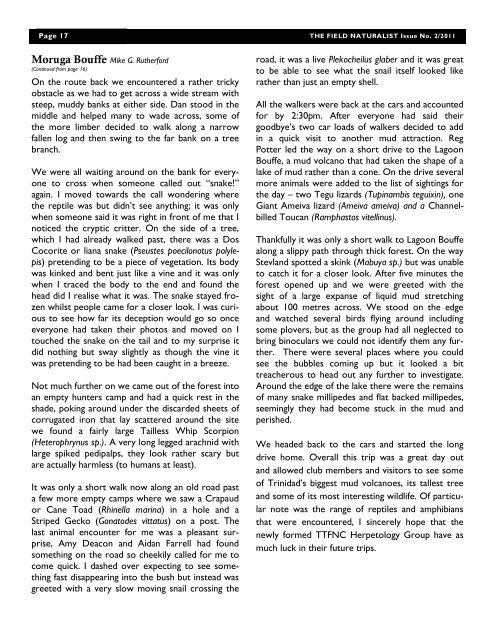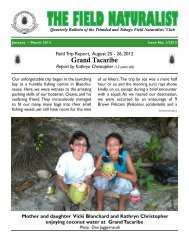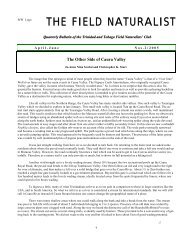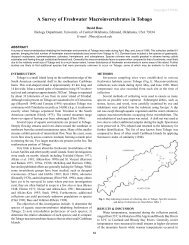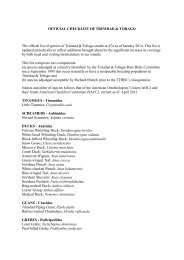Moruga Bouffe - The Trinidad and Tobago Field Naturalists' Club
Moruga Bouffe - The Trinidad and Tobago Field Naturalists' Club
Moruga Bouffe - The Trinidad and Tobago Field Naturalists' Club
You also want an ePaper? Increase the reach of your titles
YUMPU automatically turns print PDFs into web optimized ePapers that Google loves.
Page 17 THE FIELD NATURALIST Issue No. 2/2011<strong>Moruga</strong> <strong>Bouffe</strong> Mike G. Rutherford(Continued from page 16)On the route back we encountered a rather trickyobstacle as we had to get across a wide stream withsteep, muddy banks at either side. Dan stood in themiddle <strong>and</strong> helped many to wade across, some ofthe more limber decided to walk along a narrowfallen log <strong>and</strong> then swing to the far bank on a treebranch.We were all waiting around on the bank for everyoneto cross when someone called out ―snake!‖again. I moved towards the call wondering wherethe reptile was but didn’t see anything; it was onlywhen someone said it was right in front of me that Inoticed the cryptic critter. On the side of a tree,which I had already walked past, there was a DosCocorite or liana snake (Pseustes poecilonotus polylepis)pretending to be a piece of vegetation. Its bodywas kinked <strong>and</strong> bent just like a vine <strong>and</strong> it was onlywhen I traced the body to the end <strong>and</strong> found thehead did I realise what it was. <strong>The</strong> snake stayed frozenwhilst people came for a closer look. I was curiousto see how far its deception would go so onceeveryone had taken their photos <strong>and</strong> moved on Itouched the snake on the tail <strong>and</strong> to my surprise itdid nothing but sway slightly as though the vine itwas pretending to be had been caught in a breeze.Not much further on we came out of the forest intoan empty hunters camp <strong>and</strong> had a quick rest in theshade, poking around under the discarded sheets ofcorrugated iron that lay scattered around the sitewe found a fairly large Tailless Whip Scorpion(Heterophrynus sp.). A very long legged arachnid withlarge spiked pedipalps, they look rather scary butare actually harmless (to humans at least).It was only a short walk now along an old road pasta few more empty camps where we saw a Crapaudor Cane Toad (Rhinella marina) in a hole <strong>and</strong> aStriped Gecko (Gonatodes vittatus) on a post. <strong>The</strong>last animal encounter for me was a pleasant surprise,Amy Deacon <strong>and</strong> Aidan Farrell had foundsomething on the road so cheekily called for me tocome quick. I dashed over expecting to see somethingfast disappearing into the bush but instead wasgreeted with a very slow moving snail crossing theroad, it was a live Plekocheilus glaber <strong>and</strong> it was greatto be able to see what the snail itself looked likerather than just an empty shell.All the walkers were back at the cars <strong>and</strong> accountedfor by 2:30pm. After everyone had said theirgoodbye’s two car loads of walkers decided to addin a quick visit to another mud attraction. RegPotter led the way on a short drive to the Lagoon<strong>Bouffe</strong>, a mud volcano that had taken the shape of alake of mud rather than a cone. On the drive severalmore animals were added to the list of sightings forthe day – two Tegu lizards (Tupinambis teguixin), oneGiant Ameiva lizard (Ameiva ameiva) <strong>and</strong> a ChannelbilledToucan (Ramphastos vitellinus).Thankfully it was only a short walk to Lagoon <strong>Bouffe</strong>along a slippy path through thick forest. On the wayStevl<strong>and</strong> spotted a skink (Mabuya sp.) but was unableto catch it for a closer look. After five minutes theforest opened up <strong>and</strong> we were greeted with thesight of a large expanse of liquid mud stretchingabout 100 metres across. We stood on the edge<strong>and</strong> watched several birds flying around includingsome plovers, but as the group had all neglected tobring binoculars we could not identify them any further.<strong>The</strong>re were several places where you couldsee the bubbles coming up but it looked a bittreacherous to head out any further to investigate.Around the edge of the lake there were the remainsof many snake millipedes <strong>and</strong> flat backed millipedes,seemingly they had become stuck in the mud <strong>and</strong>perished.We headed back to the cars <strong>and</strong> started the longdrive home. Overall this trip was a great day out<strong>and</strong> allowed club members <strong>and</strong> visitors to see someof <strong>Trinidad</strong>’s biggest mud volcanoes, its tallest tree<strong>and</strong> some of its most interesting wildlife. Of particularnote was the range of reptiles <strong>and</strong> amphibiansthat were encountered, I sincerely hope that thenewly formed TTFNC Herpetology Group have asmuch luck in their future trips.


